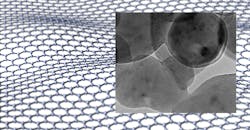Graphene Gives Aluminum-Based Explosives More Bang for the Buck
Researchers from the U.S. Army have discovered a new way to get more energy out of energetic materials containing aluminum: by coating them with graphene oxide.
This discovery coincides with the one of the Army’s modernization priorities: Long Range Precision Fires. The new fining could lead to more energetic metal powders as propellant/explosive ingredients in Army munitions.
Lauded as a miracle material, graphene is considered the strongest and lightest material in the world. It’s also the most conductive and transparent, and the most expensive to produce. Its applications are many, extending to electronics by enabling touchscreen laptops via light-emitting diode and organic light-emitting diode LCDs and OLED displays. But oxidizing graphite makes graphene oxide (GO) much less expensive to make.
Although GO is a popular two-dimensional material that has attracted intense interest across numerous disciplines and materials applications, this discovery exploits GO as an effective light-weight additive for practical energetic applications using micron-size aluminum powders (uAl)—i.e., aluminum particles one millionth of a meter in diameter. This new work signals the Army beginning to develop better metal propellant/explosive ingredients to protect more lives for the Army warfighters.
"Aluminum (Al) can theoretically release a large quantity of heat (as much as 31 kilojoules per gram) and is relatively cheap due to its natural abundance,” says Chi-Chin Wu of the Army Research Lab. “µAl powders have been widely used in energetic applications.
“However, it is difficult to ignite them using an optical flash lamp due to its poor light absorption,” Wu continues. “To improve its light absorption during ignition, it is often mixed with heavy metallic oxides which decrease the energetic performance.”
Nanometer-sized Al powders (i.e., one billionth of a meter in diameter) can be ignited more easily by a wide-area optical flash lamp , and they release heat much faster than can be achieved using conventional single-point methods such as hotwire ignition. Unfortunately, nanometer-sized Al powders are costly. The team did, however, demonstrate the value of uAl/GO composites as potential propellant/explosive ingredients. It showed that GO lets of uAl via an optical flash lamp, releasing more energy at a faster rate—thus significantly improving the energetic performance of µAl beyond that of the more expensive nanometer-sized Al powder. The team also discovered that the ignition and combustion of µAl powders can be controlled by varying the GO content to get the desired energy output.
Images showing the structure of the µAl/GO composite particles were obtained by high resolution transmission electron (TEM) microscopy. “It is exciting to see through advanced microscopy how a simple mechanical mixing process can wrap µAl particles in a GO sheet,” says Wu.
The researchers also discovered that GO increased the amount of µAl reacting in the microsecond timescale—a regime analogous to the release of explosive energy during a detonation.
Upon initiation of the uAl/GO composite with a pulsed laser using a technique called laser-induced air shock from energetic materials (LASEM), the exothermic reactions of the µAl/GO accelerated the resulting laser-induced shock velocity beyond that of pure µAl or pure GO. So µAl/GO composite can increase the power of military explosives, as well as enhance the combustion and blast effects. This could, therefore , lead to longer range and/or more lethal weapons.

